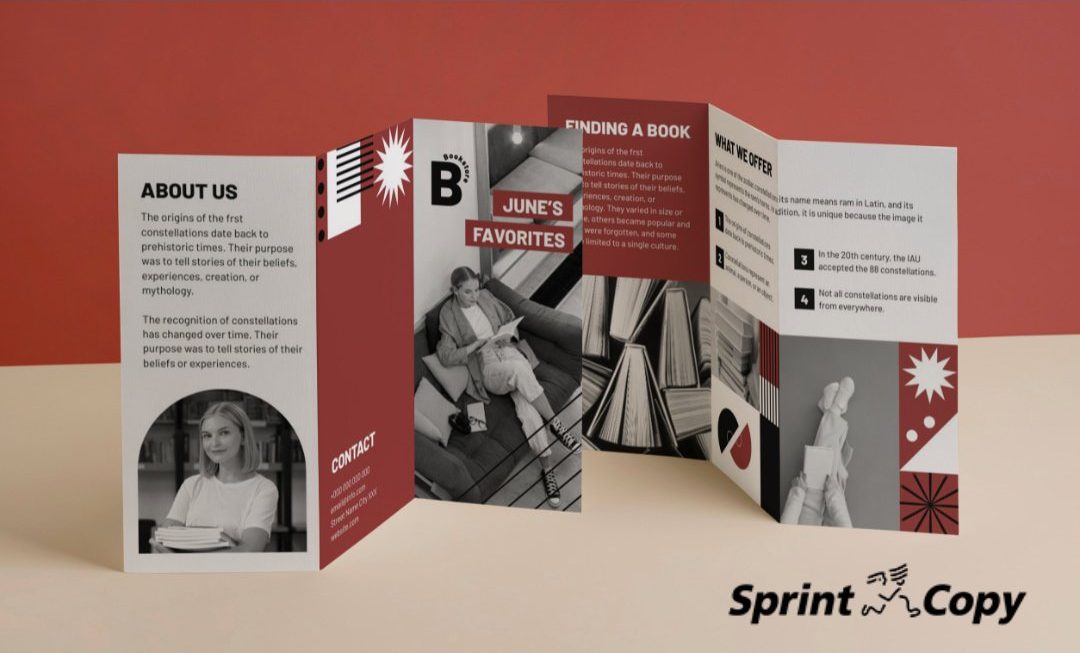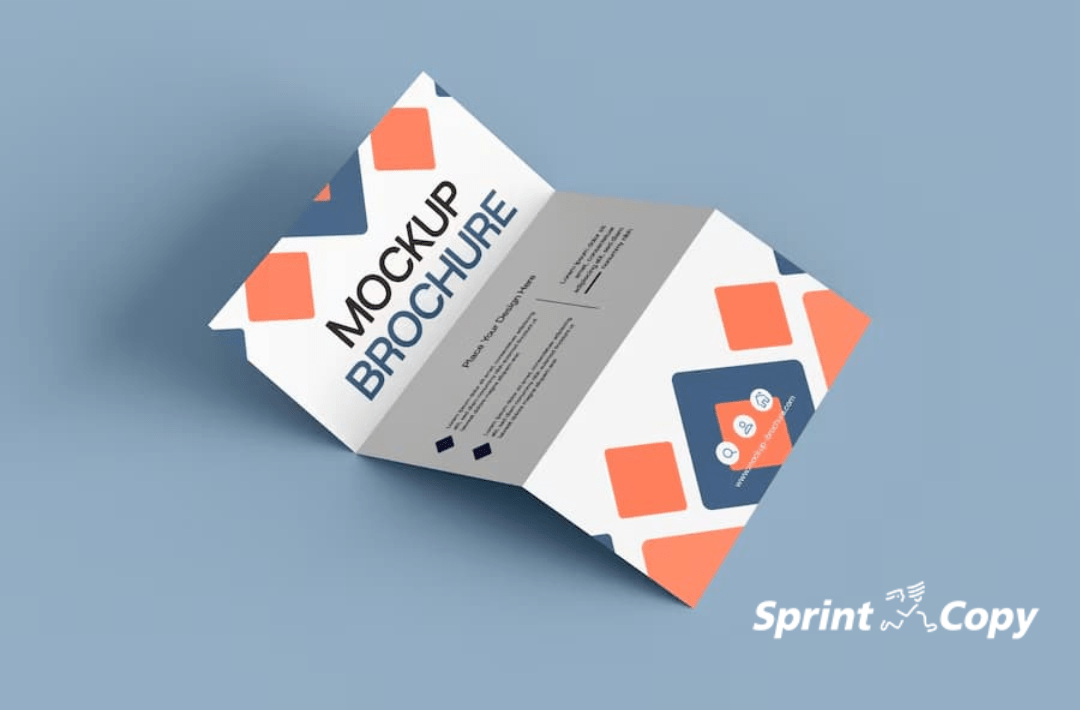Brochure materials: The guide to folded brochure papers and design
Brochure materials are essential for effective marketing strategies. Understanding the different types of brochures, such as tri-fold, Z-fold, and accordion fold, is crucial for creating impactful marketing tools. Choosing the right paper, from coated and offset to recycled options, enhances the brochure’s appeal and effectiveness. Proper design and printing techniques ensure high-quality results.
What is a brochure?
A brochure is a versatile marketing tool used by businesses to promote products or services, convey information, and engage with potential customers. Let's delve into the definition and purpose of brochures, as well as explore the different types available.
Definition and purpose
A brochure is a printed piece of marketing material that provides essential information about a business, its offerings, and other relevant details. They serve as a tangible representation of a company and are designed to capture the attention of the target audience.
Types of brochures
- Tri fold brochure
The tri-fold brochure is one of the most common types, divided into three sections that fold neatly into each other. This design allows for a structured layout, ideal for presenting information in a clear and organized manner. - Z Fold brochure
The Z-fold brochure features a zig-zag folding pattern, creating an intriguing visual appeal. It allows for information to be displayed sequentially, guiding the reader through the content in a systematic way. - Half fold brochure
The half-fold brochure is folded in half, offering a larger canvas for showcasing images and content. This format is perfect for bold visuals and impactful messaging. - Accordion fold brochure
The accordion fold brochure unfolds like an accordion, revealing multiple panels of information. This design is suitable for presenting complex details or a series of steps in a visually engaging manner.

The Importance of brochures in marketing
Engaging your target audience
Engaging your target audience is a fundamental aspect of any marketing strategy. Brochures serve as a direct communication tool with potential customers, allowing you to tailor your message to their specific needs and interests.
By using compelling visuals and persuasive language, you can captivate your audience's attention and motivate them to take action. Highlighting the benefits of your products or services in a clear and concise manner will ensure that your brochure resonates with your target demographic.
Boosting your brand visibility
Brochures play a crucial role in boosting brand visibility. They are a tangible representation of your company and can leave a lasting impression on your target audience. By incorporating your brand colors, logo, and messaging consistently throughout the brochure, you reinforce brand recognition and credibility.
Distributing brochures at strategic locations such as trade shows, events, and in-store displays can increase brand visibility and reach a wider audience. A well-designed brochure that effectively communicates your brand's values and offerings can help differentiate your business from competitors.
Delivering your message effectively
Effective communication is key to the success of any marketing campaign. Brochures allow you to deliver your message in a format that is easily digestible and visually appealing. By structuring your content in a logical flow, using headers and subheaders to break up information, and incorporating eye-catching images and graphics, you can ensure that your message is conveyed clearly and effectively.
Brochures also provide an opportunity to showcase the unique selling points of your products or services and address any potential customer concerns. By addressing key pain points and demonstrating how your offerings can solve their problems, you can build trust and credibility with your target audience.
Designing your brochure
Creating the copy
When designing your brochure, it is essential to focus on creating compelling and engaging copy. Utilize person pronouns such as 'you' and 'your' to establish a connection with the reader.
The copy and its impact
Effective copywriting can make a significant impact on the success of your brochure. Ensure that the language used is clear, concise, and tailored to appeal to your target audience.
Ensuring readability
Readability is key when it comes to designing your brochure. Use appropriate font styles, sizes, and spacing to ensure that the text is easy to read and understand.
Selecting images and graphics
Incorporating visuals into your brochure can enhance its overall appeal and attract the attention of your audience. Strike a balance between text and images to create a visually appealing layout.
Visuals for your brochure
Choose high-quality images and graphics that complement your brand and message. Visual elements should be relevant and eye-catching to engage the reader.
Balancing text and images
Ensure that there is a harmonious balance between textual content and visual elements in your brochure. The text should support the images and vice versa to create a cohesive design.
Layout and structure
The layout and structure of your brochure play a crucial role in its overall effectiveness. Organize your content in a clear and logical manner to guide the reader through the information.
Organizing your content
Arrange the content of your brochure in a structured way that flows seamlessly from one section to another. Use headings and subheadings to break up the text and make it easier to digest.
Using headers and subheaders
Headers and subheaders can help to organize your content and guide the reader through the brochure. Use them strategically to highlight key points and sections of information.
Making sure the design matches your brand
It is important to ensure that the design of your brochure aligns with your brand identity. Use colors, fonts, and imagery that are consistent with your brand to create a cohesive and recognizable piece of marketing material.
Choosing the right paper for your brochure
When creating a brochure, selecting the appropriate paper is crucial to achieving the desired look and feel. The paper chosen for the cover and interior will impact the overall presentation of the brochure. Here are the different types of paper to consider:
Types of paper for covers
- Coated Paper (Matte or Glossy): Coated paper provides a professional and polished finish to your brochure cover. Matte coatings offer a subtle and elegant look, while glossy coatings provide a more vibrant and eye-catching appearance.
- Graphic Cardboard: Graphic cardboard is a durable and sturdy option for brochure covers. It offers a premium feel and can enhance the overall perception of your brand.
- Creative Paper: Creative paper options allow for unique and customizable designs. You can choose from a variety of textures, colors, and patterns to make your brochure stand out.
Types of paper for interiors
- Offset Paper: Offset paper is a versatile and cost-effective choice for the interior pages of your brochure. It offers a smooth surface for crisp printing and is available in various weights.
- Recycled Offset Paper: Choosing recycled offset paper demonstrates your commitment to sustainability. It has a slightly textured appearance and is an eco-friendly option for environmentally conscious brands.
- Coated Paper Options: Coated paper can also be used for the interior pages of your brochure, providing a consistent finish throughout. It enhances the color vibrancy of your design and ensures a professional look.
Printing techniques and considerations
Understanding printing options
When it comes to printing your brochures, there are various options to consider. Understanding the differences between digital printing and offset printing can help you make an informed decision.
Digital printing
Digital printing is a cost-effective option for smaller print runs. It offers quick turnaround times and the ability to customize each brochure individually. This printing method is ideal for personalized marketing materials.
Offset printing
Offset printing is best suited for larger print runs. It provides high-quality, consistent results and is a more economical choice for bulk printing. Offset printing can reproduce complex designs with precision.
Ensuring high-quality prints
Ensuring that your brochures are printed to the highest quality is essential for making a lasting impression on your target audience. Working with professional printers and paying attention to color accuracy are crucial considerations.
Working with professional printers
- Choose a reputable printing company that has experience in producing high-quality brochures.
- Communicate your design requirements clearly to the printer to avoid any misunderstandings.
- Request samples of previous work to ensure the printer's capabilities meet your expectations.
Checking for color accuracy
Color accuracy plays a significant role in the overall impact of your brochure. Make sure the colors match your brand guidelines and that they are consistent throughout the entire printing process.
By understanding the printing techniques and considerations involved in creating your brochures, you can ensure that your marketing materials are of the highest quality and effectively convey your message to your target audience.
Conclusion
Choosing the right materials for your brochures is critical to achieving an impactful and professional design. From paper selection to design details, every aspect contributes to the effectiveness of your message and the perception of your brand.
At Sprintcopy, we specialise in providing high quality printing solutions in Barcelona, tailored to your specific needs. Our team of experts is ready to advise you and help you create brochures that really stand out.
Don't wait any longer, contact us today and take your brochures to the next level with Sprintcopy!

